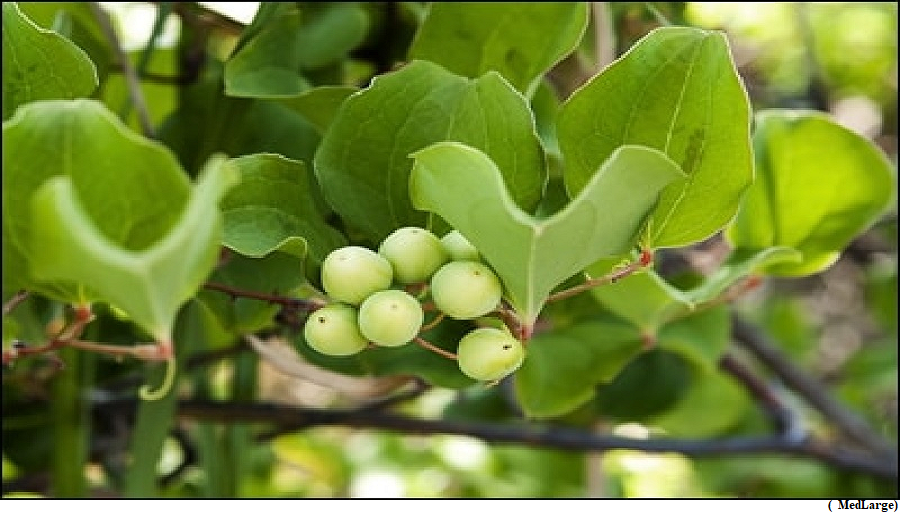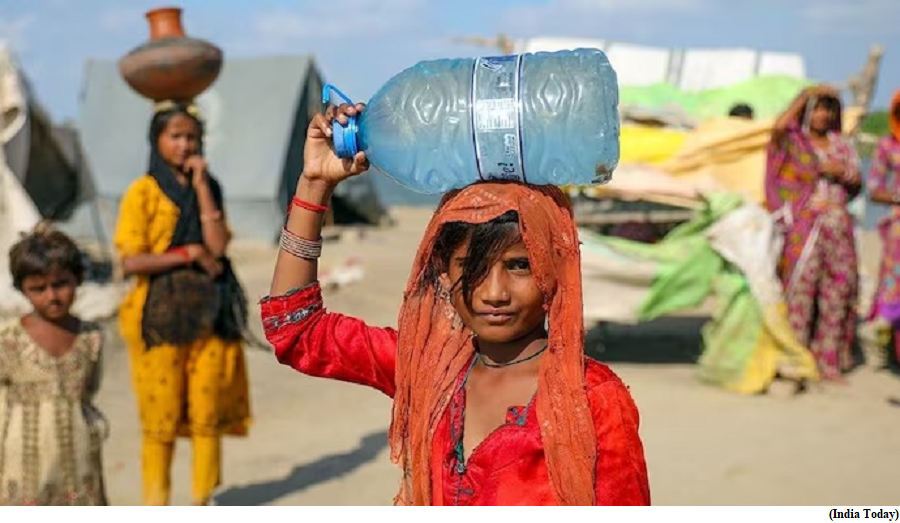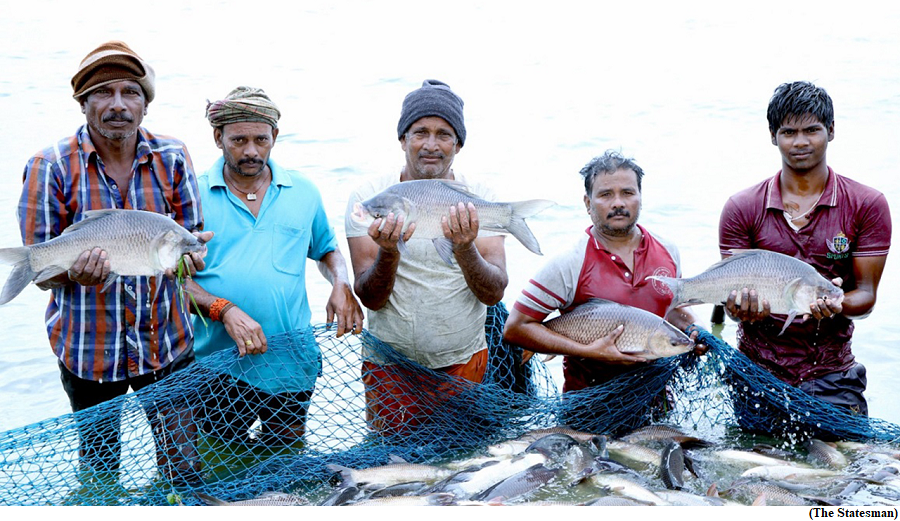Long lost wild relative of Ayurvedic therapeutic plant Chopchini rediscovered in Arunachal Pradesh (GS Paper 2, Health)

Why in news?
- The long-lost plant species, Smilax turbans, a wild counterpart of a plant that possesses anti-inflammatory properties and enhances the functioning of the immune system, has been rediscovered during a search in the pristine forests of Arunachal Pradesh.
Chopchini:
- The discovery which was made almost a century after its first collection, represents a wild counterpart of the renowned Ayurvedic therapeutic plant Chopchini (Smilax china).
- Chopchini belonging to the family Smilacaceae is recognised for its capacity to purify the bloodstream, eliminate harmful substances, treat inflammatory diseases and enhance overall well-being.
- All these characteristics along with beneficial effects on reproductive health and the gastrointestinal system render Chopchini a highly valuable botanical resource for traditional Ayurvedic therapy.
- Across the globe, there exists a total of approximately 262 distinct species, whereas, in India, they are represented by 39 species.
Smilax turbans:
- Among the 39 species, Smilax turbans, first came to light in the early 20th century when it was described by the scientists F.T. Wang & Tang, based on the specimens collected during 1911–1928 by the botanists I. H. Burkill, and F. Kingdon-Ward, during their explorations in Arunachal Pradesh.
- After its initial identification, the plant seemingly vanished from the scientific records and remained hidden from the world for an astonishing 95 years.
- Recently, this species blooming in the secluded regions of Kurung Kumey District in Arunachal Pradesh. This discovery occurred approximately 500 km from its previously documented habitat.
Significance:
- The rediscovery of Smilax turbans is not only a scientific milestone but also holds immense ecological importance. The researchers will now explore the role of this native species, in the local ecosystem, its interaction with other flora and fauna.
- Furthermore, the findings could potentially have implications for medicinal research, as various Smilax species have been known for their therapeutic properties in traditional medicine.
Way Forward:
- To protect the recently discovered plant from any risks and assure its long-term survival, a comprehensive report is being compiled for the forest department of Arunachal Pradesh.
- The report suggests ways of examining and preserving Smilax turbans within their indigenous environment while also conducting rigorous surveillance of its population dynamics and ecological interrelationships.
95 million Pakistanis under poverty, World Bank
(GS Paper 2, International Organisation)
Why in news?
- Poverty in Pakistan shot up to 39.4 per cent as of last fiscal year, with 12.5 million more people falling into the trap due to poor economic conditions, the World Bank has said, as it urged Pakistan to take urgent steps to achieve financial stability.
- It unveiled draft policy notes that it prepared with the help of all stakeholders for Pakistan's next government ahead of the new election cycle.

Key Highlights:
- Poverty in Pakistan rose within one year from 34.2 per cent to 39.4 per cent, with 12.5 million more people falling below the poverty line of the USD 3.65 per day income level. About 95 million Pakistanis now live in poverty
Policy guidelines:
- It urged Pakistan to take urgent steps to tax its 'sacred cows'; agriculture and real estate and cut wasteful expenditures in an effort to achieve economic stability through steep fiscal adjustment of over 7 per cent of the economy.
- Pointing out that the increase in poverty was consistent with ground realities, the World Bank identified low human development, unsustainable fiscal situation, over-regulated private sector, agriculture and energy sectors as the priority areas for reforms for the next government.
Tax to GDP ratio:
- It proposed measures; immediately increase the tax-to-GDP ratio by 5 per cent and cut expenditures by about 2.7 per cent of GDP, aimed to put the unsustainable economy back on a prudent fiscal path.
- Pakistan has the capacity to collect taxes equal to 22 per cent of the GDP, but its current ratio is only 10.2 per cent showing a gap of more than half.
- It proposed reducing distortive exemptions to generate taxes equal to 2 per cent of the GDP. It wanted an increase in taxes on land and property to collect another 2 per cent of GDP in revenues and generate another 1 per cent of the GDP from the agriculture sector.
Other recommendations:
- The World Bank proposed a mandatory use of CNIC (Computerised National Identity Card) for transactions, particularly of assets.
- It also proposed reducing energy and commodity subsidies, implementing a single treasury account, and imposing temporary austerity measures in the short term to save about 1 per cent of the GDP equivalent expenditures.
- In 2022, the government’s deposits in commercial banks amounted to over Rs 2 trillion, and due to its sovereign borrowings in the absence of use of this idle cash, an amount of Rs 424 billion was paid in interest.
- For the medium term, it proposed reducing federal development and current expenditures on provincial nature projects, reducing spending on loss-making entities, and improving the quality of development spending to save about Rs 1.4 trillion. The cumulative impact of these short- to medium-term savings is 2.7 per cent of the GDP.
Conclusion:
- Pakistan’s economic model is no longer reducing poverty, and the living standards have fallen behind peer countries.
Department of Fisheries is promoting Artificial Reef (AR) under PMMSY
(GS Paper 3, Economy)
Why in news?
- To promote sustainable practices, Department of Fisheries has sanctioned 732 artificial reef units for 10 coastal states with a total investment of Rs 126 crore as a sub-activity under “Integrated Modern Coastal Fishing Villages” of the Centrally Sponsored Scheme (CSS) of Pradhan Mantri Matsya Sampada Yojana (PMMSY).

Implementation:
- The projects are being implemented with the technical support of Fishery Survey of India (FSI) and ICAR-Central Marine Fisheries Research Institute (CMFRI).
- All the states have completed their site selection process while states of Kerala and Maharashtra have completed the tendering process for execution of work. Thus all projects are expected to be completed by January 2024.
What are artificial reefs?
- Artificial reefs are engineering technology interventions used to rehabilitate and/or improve natural habitats, increase productivity and manage aquatic resources including habitat enhancement.
Advantages:
- Similar to natural reefs, ARs used for aggregating fish and provide a home for fish to live and grow, reduce wave damage on coasts, helps regeneration of marine ecosystem and act as a carbon sink. As per CMFRI, two to three-fold increase in catch rates and efficiency can be realized. Thus saving fuel and energy costs leading to increased income.
- Provide a firm substrate for marine life such as corals, algae and plankton to attach to and grow They provide favorable conditions for sea ranching and serve as spawning and nursery grounds for fish.
- Enhance recreational fisheries, snorkeling, eco-tourism, creating suitable areas for diving and reducing conflicts.
- Artificial reef structures restrict bottom trawling in the near shore areas thus helping the marine environment to regenerate and small-scale fishers get higher catch
- One artificial reef of 300m3 is expected to support 25-30 non-mechanized boats (CMFRI).
About PMMSY:
- PMMSY was launched in May 2020 with the highest ever investment of Rs. 20,050 crore to bring about Blue Revolution through sustainable and responsible development of the fisheries sector.
- Over the years, increased fishing activities has reduced per capita yield from coastal fisheries, to led to heavy fishing pressure, loss of fishing grounds due to bottom trawling, coastal development etc. This has also resulted in reduced income and forcing the fishers to go to deeper waters.




